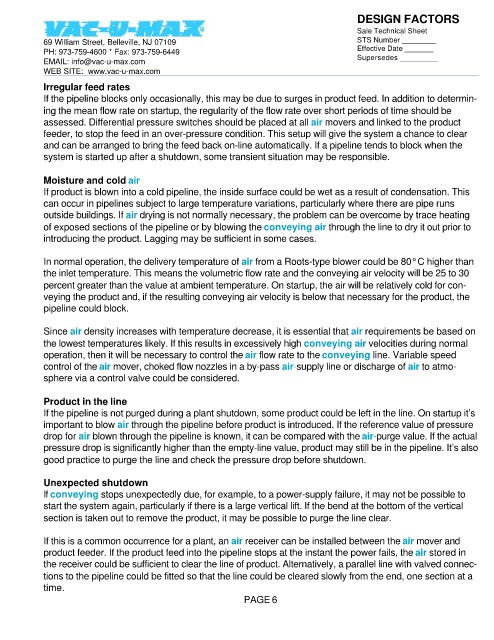Page 3046 - Flipbook_SolidDesignSoutheast2020
P. 3046
DESIGN FACTORS
Sale Technical Sheet
69 William Street, Belleville, NJ 07109 STS Number ________
PH: 973-759-4600 * Fax: 973-759-6449 Effective Date _______
EMAIL: info@vac-u-max.com Supersedes _________
WEB SITE: www.vac-u-max.com
Irregular feed rates
If the pipeline blocks only occasionally, this may be due to surges in product feed. In addition to determin-
ing the mean flow rate on startup, the regularity of the flow rate over short periods of time should be
assessed. Differential pressure switches should be placed at all air movers and linked to the product
feeder, to stop the feed in an over-pressure condition. This setup will give the system a chance to clear
and can be arranged to bring the feed back on-line automatically. If a pipeline tends to block when the
system is started up after a shutdown, some transient situation may be responsible.
Moisture and cold air
If product is blown into a cold pipeline, the inside surface could be wet as a result of condensation. This
can occur in pipelines subject to large temperature variations, particularly where there are pipe runs
outside buildings. If air drying is not normally necessary, the problem can be overcome by trace heating
of exposed sections of the pipeline or by blowing the conveying air through the line to dry it out prior to
introducing the product. Lagging may be sufficient in some cases.
In normal operation, the delivery temperature of air from a Roots-type blower could be 80° C higher than
the inlet temperature. This means the volumetric flow rate and the conveying air velocity will be 25 to 30
percent greater than the value at ambient temperature. On startup, the air will be relatively cold for con-
veying the product and, if the resulting conveying air velocity is below that necessary for the product, the
pipeline could block.
Since air density increases with temperature decrease, it is essential that air requirements be based on
the lowest temperatures likely. If this results in excessively high conveying air velocities during normal
operation, then it will be necessary to control the air flow rate to the conveying line. Variable speed
control of the air mover, choked flow nozzles in a by-pass air-supply line or discharge of air to atmo-
sphere via a control valve could be considered.
Product in the line
If the pipeline is not purged during a plant shutdown, some product could be left in the line. On startup it’s
important to blow air through the pipeline before product is introduced. If the reference value of pressure
drop for air blown through the pipeline is known, it can be compared with the air-purge value. If the actual
pressure drop is significantly higher than the empty-line value, product may still be in the pipeline. It’s also
good practice to purge the line and check the pressure drop before shutdown.
Unexpected shutdown
If conveying stops unexpectedly due, for example, to a power-supply failure, it may not be possible to
start the system again, particularly if there is a large vertical lift. If the bend at the bottom of the vertical
section is taken out to remove the product, it may be possible to purge the line clear.
If this is a common occurrence for a plant, an air receiver can be installed between the air mover and
product feeder. If the product feed into the pipeline stops at the instant the power fails, the air stored in
the receiver could be sufficient to clear the line of product. Alternatively, a parallel line with valved connec-
tions to the pipeline could be fitted so that the line could be cleared slowly from the end, one section at a
time.
PAGE 6

